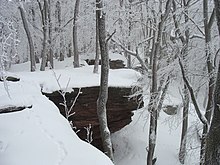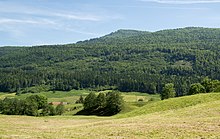| Western European broadleaf forests | |
|---|---|
 Temperate mixed forests covering the mountain slopes in
Vosges du Nord Bioreserve in Alsace, France. | |
 Ecoregion PA0445 | |
| Ecology | |
| Realm | Palearctic |
| Biome | temperate broadleaf and mixed forests |
| Borders | |
| Geography | |
| Area | 492,357 km2 (190,100 sq mi) |
| Countries | |
| Coordinates | 49°09′14″N 8°52′31″E / 49.153870°N 8.875401°E |
| Conservation | |
| Conservation status | Critical/Endangered |
The Western European broadleaf forests is an ecoregion in Western Europe, and parts of the Alps. It comprises temperate broadleaf and mixed forests, that cover large areas of France, Germany and the Czech Republic and more moderately sized parts of Poland, Austria, Switzerland, Belgium and South Limburg (Netherlands). Luxembourg is also part of this ecoregion.
Geography
The Western European broadleaf forests ecoregion covers an area of 492,357 km2 (190,100 sq mi), including the Massif Central, Central German Uplands, Jura Mountains, Bavarian Plateau, and Bohemian Massif.
This area has been inhabited for thousands of years and holds several large cities such as Lyon, Nancy and Munich. Most of the countryside has been cleared for agricultural land, cultivated with cereals ( corn, wheat, oats), and to a smaller extent grapes. The ecoregion hosts a good variety of animal species, birds in particular, but most large mammals are in decline.
Forests
The forest habitats of the ecoregion comprise mainly lowland and alti- montane mixed beech forests. There is also some natural beech woods, and the region also includes small parts of sub-Mediterranean forest habitats.
-
Broadleaf forests ( Teutoburger Forest, Germany)
-
Conifer in the montane parts
-
Inside the conifer forests ( Black Forest, Germany)
-
European beech is abundant in many submontane parts
-
Mountain streams, rocky ground, and deciduous trees in a mix with conifer
-
Autumn
-
Many valleys have been cleared for villages and agriculture
Fauna
|
| This section needs expansion. You can help by
adding to it. (September 2019) |
-
Wolf
-
Lynx
-
Wild boar
-
Stag
-
Fire salamander
-
Anthill
Status and conservation
Most of the original forest of the ecoregion has been cleared in the last 200 years, but a few larger patches remain, typically in non-arable montane areas that are part of national parks or protections. The woodlands of the ecoregion is generally second-growth and heavily fragmented.
National parks and larger nature protections in the ecoregion includes:






Luxembourg maintains the Upper Sûre Natural Park, but this park covers mostly the Upper Sûre Lake, an artificial dam created in 1959, and no land area of significance. The lake is an important bird area. Luxembourg also holds part of the cross-border German-Luxembourg Nature Park in addition to several smaller nature reservations. Here eco-typical patches of forest are growing.
Austria does not have any protections in this ecoregion.
External links
- "Western European broadleaf forests". Terrestrial Ecoregions. World Wildlife Fund.
References
- ^ Note that the year given here, marks the earliest establishment. Several protections has been expanded later on.
- ^ Note that forest might not cover all of the protected area.
- ^ "Naturpark Sauerland Rothaargebirge" (in German). Retrieved 11 September 2019.
- ^ "Le Parc naturel des deux Ourthes" (in French). Retrieved 11 September 2019.
- ^ "Parc naturel Haute-Sûre Forêt d'Anlier" (in French). Retrieved 11 September 2019.
- ^ "Parc naturel régional des Ardennes" (in French). Fédération des Parcs naturels régionaux de France. Retrieved 11 September 2019.
- ^ "Parc naturel régional du Massif des Bauges" (in French). Fédération des Parcs naturels régionaux de France. Retrieved 11 September 2019.
- ^ "Parc naturel régional des Grands Causses" (in French). Fédération des Parcs naturels régionaux de France. Retrieved 11 September 2019.
- ^ "Parc naturel régional Aubrac" (in French). Fédération des Parcs naturels régionaux de France. Retrieved 11 September 2019.
- ^ "Parc naturel régional des Volcans d'Auvergne" (in French). Fédération des Parcs naturels régionaux de France. Retrieved 11 September 2019.
- ^ "Parc naturel régional de Millevaches en Limousin" (in French). Fédération des Parcs naturels régionaux de France. Retrieved 11 September 2019.
- Ecoregions of Austria
- Ecoregions of Belgium
- Ecoregions of the Czech Republic
- Ecoregions of Europe
- Ecoregions of France
- Ecoregions of Metropolitan France
- Ecoregions of Germany
- Ecoregions of Poland
- Ecoregions of Switzerland
- Forests of the Czech Republic
- Forests of France
- Forests of Switzerland
- Forests of Luxembourg
- Forests and woodlands of Austria
- Forests and woodlands of Germany
- Montane forests
- Natural history of Luxembourg
- Palearctic ecoregions
- Temperate broadleaf and mixed forests
- Ecoregions of the Netherlands
| Western European broadleaf forests | |
|---|---|
 Temperate mixed forests covering the mountain slopes in
Vosges du Nord Bioreserve in Alsace, France. | |
 Ecoregion PA0445 | |
| Ecology | |
| Realm | Palearctic |
| Biome | temperate broadleaf and mixed forests |
| Borders | |
| Geography | |
| Area | 492,357 km2 (190,100 sq mi) |
| Countries | |
| Coordinates | 49°09′14″N 8°52′31″E / 49.153870°N 8.875401°E |
| Conservation | |
| Conservation status | Critical/Endangered |
The Western European broadleaf forests is an ecoregion in Western Europe, and parts of the Alps. It comprises temperate broadleaf and mixed forests, that cover large areas of France, Germany and the Czech Republic and more moderately sized parts of Poland, Austria, Switzerland, Belgium and South Limburg (Netherlands). Luxembourg is also part of this ecoregion.
Geography
The Western European broadleaf forests ecoregion covers an area of 492,357 km2 (190,100 sq mi), including the Massif Central, Central German Uplands, Jura Mountains, Bavarian Plateau, and Bohemian Massif.
This area has been inhabited for thousands of years and holds several large cities such as Lyon, Nancy and Munich. Most of the countryside has been cleared for agricultural land, cultivated with cereals ( corn, wheat, oats), and to a smaller extent grapes. The ecoregion hosts a good variety of animal species, birds in particular, but most large mammals are in decline.
Forests
The forest habitats of the ecoregion comprise mainly lowland and alti- montane mixed beech forests. There is also some natural beech woods, and the region also includes small parts of sub-Mediterranean forest habitats.
-
Broadleaf forests ( Teutoburger Forest, Germany)
-
Conifer in the montane parts
-
Inside the conifer forests ( Black Forest, Germany)
-
European beech is abundant in many submontane parts
-
Mountain streams, rocky ground, and deciduous trees in a mix with conifer
-
Autumn
-
Many valleys have been cleared for villages and agriculture
Fauna
|
| This section needs expansion. You can help by
adding to it. (September 2019) |
-
Wolf
-
Lynx
-
Wild boar
-
Stag
-
Fire salamander
-
Anthill
Status and conservation
Most of the original forest of the ecoregion has been cleared in the last 200 years, but a few larger patches remain, typically in non-arable montane areas that are part of national parks or protections. The woodlands of the ecoregion is generally second-growth and heavily fragmented.
National parks and larger nature protections in the ecoregion includes:






Luxembourg maintains the Upper Sûre Natural Park, but this park covers mostly the Upper Sûre Lake, an artificial dam created in 1959, and no land area of significance. The lake is an important bird area. Luxembourg also holds part of the cross-border German-Luxembourg Nature Park in addition to several smaller nature reservations. Here eco-typical patches of forest are growing.
Austria does not have any protections in this ecoregion.
External links
- "Western European broadleaf forests". Terrestrial Ecoregions. World Wildlife Fund.
References
- ^ Note that the year given here, marks the earliest establishment. Several protections has been expanded later on.
- ^ Note that forest might not cover all of the protected area.
- ^ "Naturpark Sauerland Rothaargebirge" (in German). Retrieved 11 September 2019.
- ^ "Le Parc naturel des deux Ourthes" (in French). Retrieved 11 September 2019.
- ^ "Parc naturel Haute-Sûre Forêt d'Anlier" (in French). Retrieved 11 September 2019.
- ^ "Parc naturel régional des Ardennes" (in French). Fédération des Parcs naturels régionaux de France. Retrieved 11 September 2019.
- ^ "Parc naturel régional du Massif des Bauges" (in French). Fédération des Parcs naturels régionaux de France. Retrieved 11 September 2019.
- ^ "Parc naturel régional des Grands Causses" (in French). Fédération des Parcs naturels régionaux de France. Retrieved 11 September 2019.
- ^ "Parc naturel régional Aubrac" (in French). Fédération des Parcs naturels régionaux de France. Retrieved 11 September 2019.
- ^ "Parc naturel régional des Volcans d'Auvergne" (in French). Fédération des Parcs naturels régionaux de France. Retrieved 11 September 2019.
- ^ "Parc naturel régional de Millevaches en Limousin" (in French). Fédération des Parcs naturels régionaux de France. Retrieved 11 September 2019.
- Ecoregions of Austria
- Ecoregions of Belgium
- Ecoregions of the Czech Republic
- Ecoregions of Europe
- Ecoregions of France
- Ecoregions of Metropolitan France
- Ecoregions of Germany
- Ecoregions of Poland
- Ecoregions of Switzerland
- Forests of the Czech Republic
- Forests of France
- Forests of Switzerland
- Forests of Luxembourg
- Forests and woodlands of Austria
- Forests and woodlands of Germany
- Montane forests
- Natural history of Luxembourg
- Palearctic ecoregions
- Temperate broadleaf and mixed forests
- Ecoregions of the Netherlands












